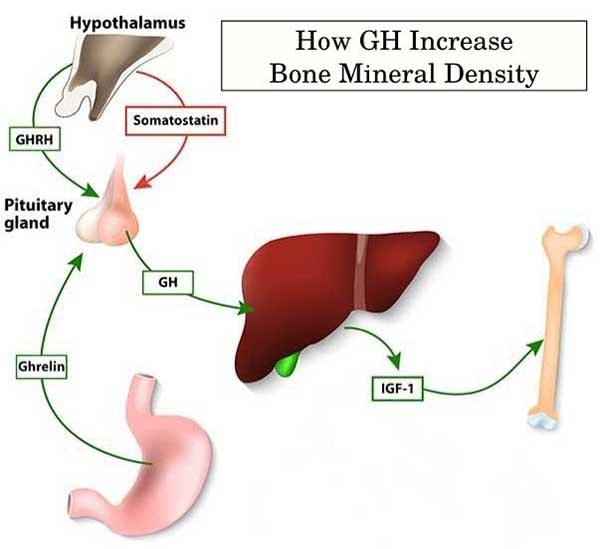If you have growth hormone deficiency (GHD), this endocrinological imbalance can have long-term consequences on your skeletal integrity.
GHD increases your risk of osteoporosis which is often associated with bone fractures, immobilization, and long-term disability.
The underlying cause is the decrease in bone mineral density which can occur due to long-term GHD. Thus, bone loss is most common in patients with severe deficiency who have not received treatment for years.
Low bone mineral density also slows down the healing process after a bone fracture which can cause long-term immobilization, disability, and even increased mortality.
In the case of GHD, the most effective way to restore the hormonal balance in your body and increase your bone mineral density is via proper medical treatment.
Starting HGH replacement therapy as soon as possible can prevent bone loss and reduce your risks of suffering from osteoporosis.
HGH therapy increases bone strength
HGH and its main anabolic metabolite called Insulin-like Growth Factor 1 (IGF-1) affect both bone resorption and formation which are the two key processes that control bone remodeling.
Once HGH therapy is initiated, resorption may temporarily dominate in the process of bone remodeling which can lead to a slight decrease in bone mineral density. Yet, this is only a temporary effect that helps improve bone microarchitecture and strength.
The process of bone formation prevails soon after and leads to increased production of bone tissue.
IGF-1 stimulates the process by activating your osteoblasts – the cells in your skeleton that form new bone tissue. Furthermore, IGF-1 stimulates the production of collagen, which is the main protein in bone and provides elasticity.
HGH also has direct benefits in suppressing bone resorption after the initial remodeling is complete.
HGH reduces the risk of fractures
As a result of all these effects, your bone mineral density will increase, which reduces your risk of osteoporosis and bone fractures.
Researchers confirm that 3 years of continuous HGH therapy can reduce the number of bone fractures by half in postmenopausal women. What is more, the effect was sustained for the next 10 years after the treatment.
HGH therapy can speed up bone healing after a fracture. That is thanks to the stimulatory effects of IGF-1 on cell proliferation which is a key part of the repair processes in your body. This is how HGH therapy helps in the recovery of other tissues and organs.
How long does it take for HGH to improve bone mineral density?
The benefits for bone mineral density occur considerably slower compared to HGH results at 1-2 months. After the initial increase in bone resorption, it may take at least 4-6 months of treatment until there is any detectable increase in bone mass.
Furthermore, it will take up to several years of HGH therapy until the benefits for your bone mineral density reach a peak.
Keep in mind that none of the effects of the treatment are permanent. Yet, long-term HGH therapy can lead to a sustained increase in bone mineral density, which persists long after the end of the treatment.
What else do you get with increased bone density?
If you have higher bone density, you will be much less likely to experience bone fractures in case of a trauma or injury.
By preventing osteoporosis, you are at a lower risk of being bed-ridden after an injury or suffer long-term disability.
Furthermore, stronger and denser bones will also help improve your posture which can help boost your confidence and increase physical mobility. In turn, this can help increase your athletic performance and quality of life.
Get a free consultation with our medical expert for any questions about hormone replacement therapy


